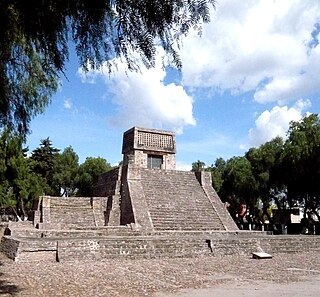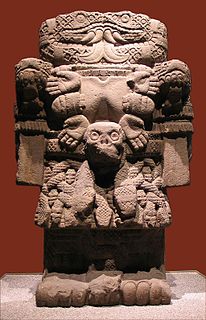Related Research Articles

The Toltec culture is a pre-Columbian Mesoamerican culture that ruled a state centered in Tula, Hidalgo, Mexico in the early post-classic period of Mesoamerican chronology. The later Aztec culture saw the Toltecs as their intellectual and cultural predecessors and described Toltec culture emanating from Tōllān[ˈtoːlːaːn] as the epitome of civilization; in the Nahuatl language the word Tōltēcatl[toːlˈteːkat͡ɬ] (singular) or Tōltēcah[toːlˈteːkaʔ] (plural) came to take on the meaning "artisan". The Aztec oral and pictographic tradition also described the history of a Toltec Empire, giving lists of rulers and their exploits.

The Aztecs were a Mesoamerican culture that flourished in central Mexico in the post-classic period from 1300 to 1521. The Aztec peoples included different ethnic groups of central Mexico, particularly those groups who spoke the Nahuatl language and who dominated large parts of Mesoamerica from the 14th to the 16th centuries. Aztec culture was organized into city-states (altepetl), some of which joined to form alliances, political confederations, or empires. The Aztec Empire was a confederation of three city-states established in 1427: Tenochtitlan, city-state of the Mexica or Tenochca; Texcoco; and Tlacopan, previously part of the Tepanec empire, whose dominant power was Azcapotzalco. Although the term Aztecs is often narrowly restricted to the Mexica of Tenochtitlan, it is also broadly used to refer to Nahua polities or peoples of central Mexico in the prehispanic era, as well as the Spanish colonial era (1521–1821). The definitions of Aztec and Aztecs have long been the topic of scholarly discussion ever since German scientist Alexander von Humboldt established its common usage in the early nineteenth century.

The Aztec or Mexica calendar is the calendrical system used by the Aztecs as well as other Pre-Columbian peoples of central Mexico. It is one of the Mesoamerican calendars, sharing the basic structure of calendars from throughout ancient Mesoamerica.

The Mesoamerican ballgame was a sport with ritual associations played since at least 1650 BC by the pre-Columbian people of Ancient Mesoamerica. The sport had different versions in different places during the millennia, and a newer, more modern version of the game, ulama, is still played by the indigenous populations in some places.

Lake Texcoco was a natural lake within the "Anahuac" or Valley of Mexico. Lake Texcoco is best known as where the Aztecs built the city of Tenochtitlan, which was located on an island within the lake. After the Spanish conquest of the Aztec Empire, efforts to control flooding by the Spanish led to most of the lake being drained. The entire lake basin is now almost completely occupied by Mexico City, the capital of the present-day nation of Mexico.
Tlatoani is the Classical Nahuatl term for the ruler of an āltepētl, a pre-Hispanic state. It can be translated to English as "king," and Huey Tlatoani is translated as "great king." A cihuātlahtoāni is a female ruler, or queen regnant.

The Aztec sun stone is a late post-classic Mexica sculpture housed in the National Anthropology Museum in Mexico City, and is perhaps the most famous work of Mexica sculpture. It measures 358 centimetres (141 in) in diameter and 98 centimetres (39 in) thick, and weighs 24,590 kg (54,210 lb). Shortly after the Spanish conquest, the monolithic sculpture was buried in the Zócalo, the main square of Mexico City. It was rediscovered on 17 December 1790 during repairs on the Mexico City Cathedral. Following its rediscovery, the sun stone was mounted on an exterior wall of the cathedral, where it remained until 1885. Early scholars initially thought that the stone was carved in the 1470s, though modern research suggests that it was carved some time between 1502 and 1521.

The Aztecs were a Pre-Columbian Mesoamerican people of central Mexico in the 14th, 15th, and 16th centuries. They called themselves Mēxihcah.

Aztec architecture is a late form of Mesoamerican architecture developed by the Aztec civilization. Much of what is known about it comes from the structures that are still standing. These structures have survived for several centuries because of the strong materials used and the skill of the builders.

The Mexica (Nahuatl: Mēxihcah, Nahuatl pronunciation: [meːˈʃiʔkaʔ]; singular Mēxihcatl, or Mexicas, were a Nahuatl-speaking indigenous people of the Valley of Mexico who were the rulers of the Aztec Empire. They were the last Nahua-speaking immigrants to enter the Basin of Mexico after the decline of the Toltecs. The group was also known as the Culhua-Mexica in recognition of its kinship alliance with the neighboring Culhua, descendants of the revered Toltecs]s, who occupied the Toltec capital of Tula from the 10th to the 12th centuries. The Mexica of Tenochtitlan were additionally referred to as the "Tenochca," a term associated with the name of their altepetl, Tenochtitlan, and Tenochtitlan's founding leader, Tenoch. The Mexica established Mexico Tenochtitlan, a settlement on an island in Lake Texcoco. A dissident group in Mexico-Tenochtitlan separated and founded the settlement of Mexico-Tlatelolco with its own dynastic lineage. The Mexica of Tlatelolco were also known as Tlatelolca.

The Battle of Tlatelolco was fought between the two pre-Hispanic altepetls Tenochtitlan and Tlatelolco, two independent polities which inhabited the island of Lake Texcoco in the Basin of Mexico.

The Coatlicue statue is one of the most famous surviving Aztec sculptures. It is a 2.52 metre (8.3 ft) tall andesite statue by an unidentified Mexica artist. Although there are debates about what or who the statue represents, it is usually identified as the Aztec deity Coatlicue ("Snakes-Her-Skirt"). It is currently located in the National Museum of Anthropology in Mexico City. Originally displayed in the Mexica city of Tenochtitlan, the momentous statue was buried after the 1521 Spanish conquest of the city and excavated roughly 270 years later in 1790.
Ross Hassig is an American historical anthropologist specializing in Mesoamerican studies, particularly the Aztec culture. His focus is often on the description of practical infrastructure in Mesoamerican societies. He is the author of several influential books, among them: Time, History, and Belief in Aztec and Colonial Mexico; Aztec Warfare: Imperial Expansion and Political Control; and Trade, Tribute, and Transportation: The Sixteenth-Century Political Economy of the Valley of Mexico.

The Coyolxāuhqui Stone is a carved, circular Aztec stone, depicting the mythical being Coyolxāuhqui ("Bells-Her-Cheeks"), in a state of dismemberment and decapitation by her brother, the patron deity of the Aztecs, Huitzilopochtli. It was rediscovered in 1978 at the site of the Templo Mayor of Tenochtitlan, now in Mexico City. This relief is one of the best known Aztec monuments and one of the few great Aztec monuments that have been found fully in situ.
Elizabeth Hill Boone is an American art historian, ethnohistorian and academic, specialising in the study of Latin American art and in particular the early colonial and pre-Columbian art, iconography and pictoral codices associated with the Mixtec, Aztec and other Mesoamerican cultures in the central Mexican region. Her extensive published research covers investigations into the nature of Aztec writing, the symbolism and structure of Aztec art and iconography and the interpretation of Mixtec and Aztec codices.
Cuāuhtlahtoāni or Cuäuhtlahtoh is a titular office of governorship and political administration, used within certain city-states and provinces among the Aztecs of pre-Columbian central Mexico in the Late Postclassic period. The office of cuauhtlatoani carried the connotation of "military ruler" or "appointed administrator". During the rise of the Aztec Empire the title was given by the ruling Mexica-Tenochca to the governors they imposed on conquered city-states in central provinces.

Tenayuca is a pre-Columbian Mesoamerican archaeological site in the Valley of Mexico. In the Postclassic period of Mesoamerican chronology, Tenayuca was a settlement on the former shoreline of the western arm of Lake Texcoco. It was located approximately 10 kilometres (6.2 mi) to the northwest of Tenochtitlan.
David C. Grove is an American anthropologist, archaeologist and academic, known for his contributions and research into the Preclassic period cultures of Mesoamerica, in particular those of the Mexican altiplano and Gulf Coast regions. A lecturer and professor at University of Illinois at Urbana-Champaign (UIUC) for some thirty years, Grove retains a position as Professor Emeritus of Anthropology at UIUC and is also designated a Courtesy Professor of Anthropology at the University of Florida.
Jane MacLaren Walsh is an anthropologist and researcher at the Smithsonian's National Museum of Natural History in Washington, D.C. She is known for her role in exposing faked pre-Columbian artifacts.
Thelma Dorfman Sullivan was an American paleographer, linguist and translator, regarded as one of the foremost scholars in the 20th century of the Classical Nahuatl language. Significant works include a compendium of Nahuatl grammar (1976), noted as the most comprehensive treatment of its day, and her translation of Bernardino de Sahagún's 16th-century text known as the Primeros Memoriales, completed by colleagues after her death.
References
- ↑ "CSUSB Search". search.csusb.edu. Retrieved 24 December 2018.
- ↑ "Frances Berdan - CSULA AHS Mesoamerican Conference 2012". csulaahsmesoamericanconference2012.wordpress.com.
- ↑ Carder, James N. "Frances Berdan — Dumbarton Oaks". www.doaks.org.